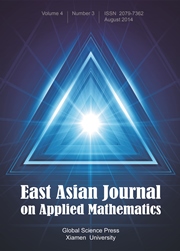Article contents
A Dispersive Numerical Model for the Formation of Undular Bores Generated by Tsunami Wave Fission
Published online by Cambridge University Press: 31 January 2018
Abstract
A two-layer non-hydrostatic numerical model is proposed to simulate the formation of undular bores by tsunami wave fission. These phenomena could not be produced by a hydrostatic model. Here, we derived a modified Shallow Water Equations with involving hydrodynamic pressure using two layer approach. Staggered finite volume method with predictor corrector step is applied to solve the equation numerically. Numerical dispersion relation is derived from our model to confirm the exact linear dispersion relation for dispersive waves. To illustrate the performance of our non-hydrostatic scheme in case of linear wave dispersion and non-linearity, four test cases of free surface flows are provided. The first test case is standing wave in a closed basin, which test the ability of the numerical scheme in simulating dispersive wave motion with the correct frequency. The second test case is the solitary wave propagation as the examination of owing balance between dispersion and nonlinearity. Regular wave propagation over a submerged bar test by Beji is simulated to show that our non-hydrostatic scheme described well the shoaling process as well as the linear dispersion compared with the experimental data. The last test case is the undular bore propagation.
Keywords
MSC classification
- Type
- Research Article
- Information
- Copyright
- Copyright © Global-Science Press 2017
References
- 4
- Cited by


